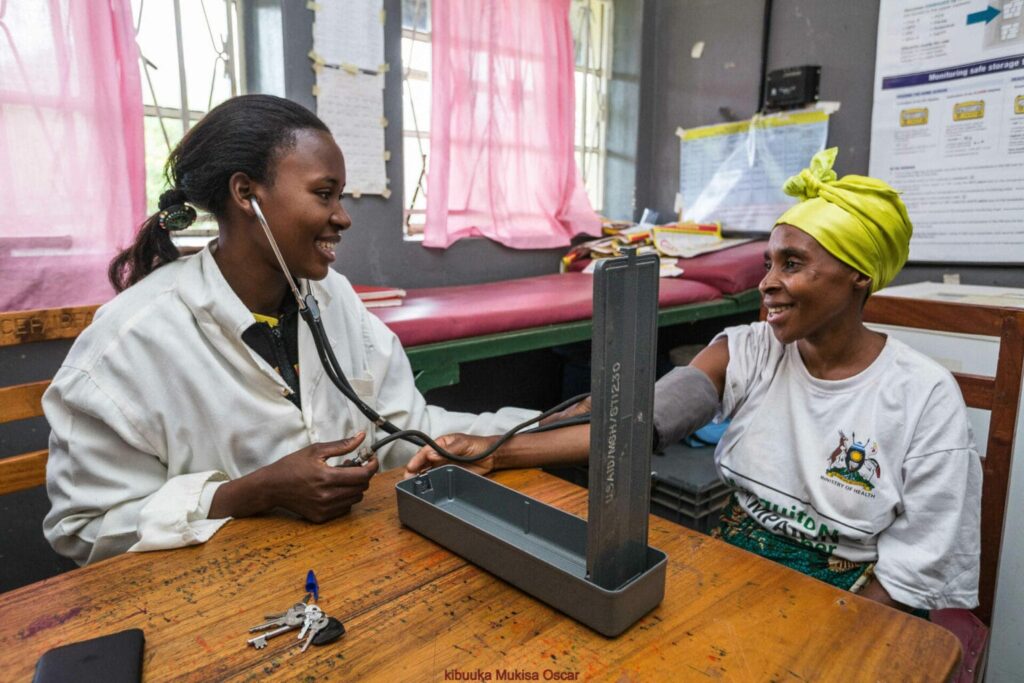L’Initiative has broadened its interventions to include fighting cervical cancer, which is caused by human papillomaviruses (HPV). These sexually transmitted viruses, which are highly contagious, are particularly deadly for women living with HIV.
Human papillomaviruses are very widespread infectious agents that are highly contagious and mainly transmitted through sexual activity. The vast majority of sexually active women and men will be affected by one of the 200 types of papillomaviruses during their lifetimes. However, some HPVs are known to have a high risk of causing cancer. These HPV infections are likely to persist and develop into genital warts and severe lesions or cancers, in particular cervical cancer in women.
A threat to global health
In 2020, 604,000 new cases of cervical cancer were recorded worldwide, all of which were caused by HPV infections. This form of cancer disproportionately affects women living in low and middle-income countries, especially in Africa, where 85% of global cases are reported.
Cervical cancer also clearly reveals global inequalities. Incidence rates are much higher among women who are screened late, who have limited access to healthcare services, or who are exposed to additional risk factors (in particular HIV, but also smoking). Cervical cancer is the fourth most common cancer in women worldwide, but it is the second most common in Africa.

Responding to a double vulnerability
For many women, HIV and cervical cancer can be a tragic double burden. This is because these two diseases feed off one another: on the one hand, women with HIV are six times more likely to develop cervical cancer, while on the other, women infected by a human papillomavirus are at greater risk of contracting HIV.
Once again, women in Africa are particularly exposed to this double vulnerability. The number of African women living with one of these viruses is disproportionately high, and they have to deal with fragile health systems that offer very limited access to vaccination, screening, and treatment.
The goal of eliminating cervical cancer
Cervical cancer is the only non-communicable disease that can be eradicated. It can be prevented by vaccinating against papillomaviruses and treating precancerous lesions, and, when detected early enough, it can be treated. And yet, although effective solutions are available, HPV continues to spread, causing hundreds of thousands of women to develop cervical cancer around the world due to numerous barriers to accessing care.
These barriers to care include:
- the high cost of effective screening techniques;
- the slow uptake of secondary prevention (treating precancerous lesions) in national guidelines;
- delays in implementing vaccination against HPV due to the cost of the vaccine, but also because it is linked with sexuality, which remains taboo in many societies.
In addition to these barriers, there are also other obstacles, such as lack of knowledge about HPV and its consequences and the cost of health services for patients.
L’Initiative aligns its work with the WHO strategy to eliminate cervical cancer by 2030 by mainstreaming vaccination, screening, and treatment worldwide. We, therefore, support both operational research and field projects.
Supporting operational research
L’Initiative specifically dedicated its 2022 call for operational research projects to HIV/HPV co-infection and related cancers. The objective was to test and validate innovative strategies to improve prevention, diagnosis, and early treatment services for HPV-related cancers in people living with HIV.
Integrating screening into healthcare
In Cameroon, the French research institute Bouisson Bertrand is assessing a strategy to include cervical cancer screening in a comprehensive sexual and reproductive health program.


Evaluating the feasibility and acceptability of self-sampling
Au Ghana, l’Institut de recherche Noguchi Memorial évalue l’acceptabilité et la fiabilité de l’autoprélèvement pour le test HPV et, plus largement, cherche à déterminer la meilleure manière d’intégrer ce dépistage aux soins de routine pour les femmes vivant avec le VIH.
Optimizing screening strategies
In Cameroon, the French National Research Institute for Sustainable Development (IRD) is striving to optimize screening strategies for cervical cancer when women living with HIV test positive for HPV.

Rolling out solutions on the ground
L’Initiative and its partners support innovative approaches to prevent HPV by taking into account the entire spectrum of HPV and HIV infections, as well as associated cancers.
The first step is to roll out large-scale vaccination of teenagers against HPV. This primary prevention strategy offers the most effective and lasting protection against the papillomavirus. We also support activities known as secondary prevention. These activities involve innovative techniques to screen for HPV and treat precancerous lesions (precise detection of HPV using molecular biology, treatment using thermal ablation, digital monitoring of patients over several years, etc.).

SUCCESS : Un projet phare pour contrer le cancer du col de l’utérus
The WHO targets cannot be achieved without providing substantial funding, in particular for the most vulnerable countries. L’Initiative is contributing to this effort by supporting the SUCCESS project, which is backed by Unitaid. This program has enabled innovative approaches to be implemented and integrated into cervical cancer prevention standards, strategic plans, and education, information, and communication tools in Burkina Faso, Côte d’Ivoire, Guatemala, and the Philippines. It is now being extended to other countries, such as Guinea and Benin.
Providing tools for experts
L’Initiative offers many resources for our experts working on technical assistance missions to promote equal access to knowledge and thus reduce unfair, preventable, and reparable inequalities. For example, L’Initiative has collated knowledge about HPV into a publication entitled: “Toolkit – Engagement in the cervical cancer response, various HIV integration opportunities.” L’Initiative provides many relevant documents to help program experts work toward integrating cervical cancer prevention services into HIV care. This may include updating national strategic plans, writing funding requests to the Global Fund, explaining the results of scientific research, or conducting studies


